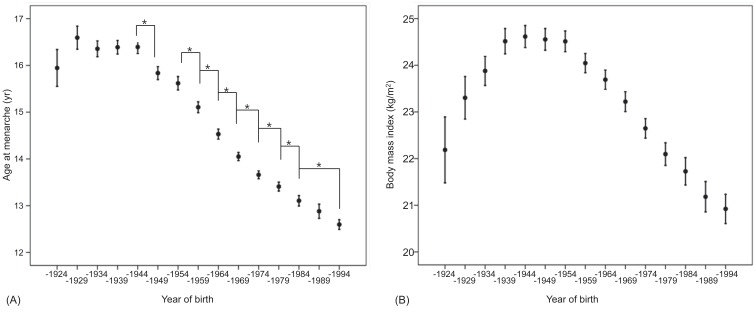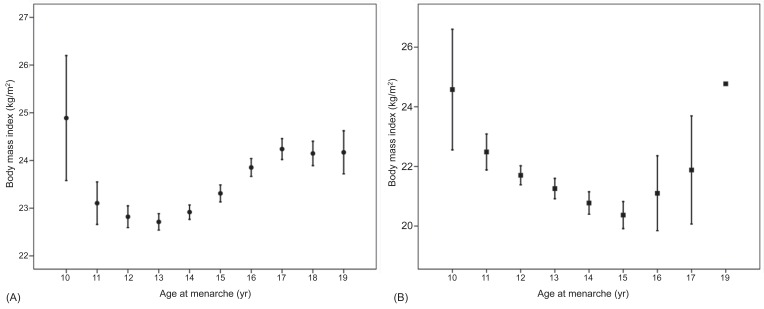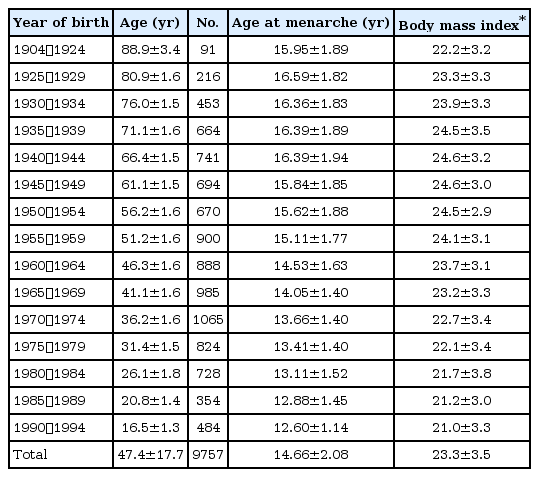Age at menarche in the Korean female: secular trends and relationship to adulthood body mass index
Article information
Abstract
Purpose
The objective of this study is to estimate the trend in age at menarche in the Korean female and evaluate the relationship between age at menarche and adult body mass index (BMI), which is a indicator of later-life health.
Methods
We conducted a cross-sectional analysis of a nationally representative sample (self-reported age at menarche and measured height and weight) of 11,065 females aged 15 and older. Data were obtained from the Fourth Korea National Health and Nutrition Examination Survey (KNHANES IV, 2007-2009).
Results
We found a statistically significant decline in age at menarche in successive birth groups, indicating a 0.726 year decrease per decade. The age at menarche in 1990-1994 year birth group was 12.60 years, which showed a significant decreased from 3.11 years in the 1980-1984 birth group. We also found a significant negative association between age at menarche and current BMI. A one-year decrease in age at menarche was associated with mean BMI increase of 0.109 kg/m2 (95% confidence interval [CI], 0.069 to 0.150) after adjustment for age. In multivariate logistic regression, the odds ratios of obesity in females with early menarche (<12 years) was 1.845 fold (95% CI, 1.441 to 2.361).
Conclusion
We found that age at menarche is still falling in the Korean female. We also found that early menarche is a risk factor for obesity in adults.
Introduction
Age at menarche is a key maturity indicator of female development, and it is known to reflect population health1). For example, an early menarche is a risk factor for cancer and cardiovascular disease mortality2,3). In Korea like other Western countries, a decrease in age at menarche over time has been consistently observed until mid-20th century birth cohorts, probably because of improvements in nutrition4,5). Despite the similar secular change, the magnitude of decreasing rate of age at menarche is not consistently observed in all studies1,6). This might be due to that age at menarche is known to be influenced by various factors such as ethnicity, nutrition status, geography, and socioeconomic status6-10). In western countries, the downward trend in age at menarche had stopped near 12.60 years11-15). However, the age at menarche was continuously decreased until 1980 in Korea5).
Several studies have established an association between early menarche and the risk of obesity and other chronic disease such as cancers, cardiovascular disease and type 2 diabetes2,3,16-20). However, population-based studies about the association between age at menarche and obesity in adult female are lacking even though Korean also had high prevalence associations are exists between age at menarche and current adult BMI in a nationally representative population. of obesity including children21). Obesity is also well known important risk of other chronic disease such as cardiovascular disease and type 2 diabetes including Korean22).
The aim of this study is: 1) to assess whether secular trend of age at menarche in Korean female still exists comparing previous Korean studies; and 2) to investigate whether the associations are exists between age at menarche and current adult BMI in a nationally representative population.
Materials and methods
The Fourth Kore a National He alth and Nutrition Examination Survey (KNHANES IV, 2007-2009) was a cross-sectional and nationally representative survey with a multistage and stratified sampling design conducted by the Division of Chronic Disease Surveillance, Korea Centers for Disease Control and Prevention. The raw data of KNHANES IV was released for public health study under the national policy and study-specific ethics approval was obtained.
We select 11,065 female aged older than 15 years among 31,705 individuals. Among them, 9,757 subjects (88.2%) selfreported their age at menarche. Age at menarche was defined as age at the first menstrual period. This information was gained from the questionnaire. The question was open-ended: "At what age did you have your first menstrual period (menarche)?" When subjects reported their age at menarche as 12.00 to 12.99 year, then age at menarche was designated as 12 year.
In KNHANES IV, the anthropometric data was collected after informed consent and standardized questionnaire. Weight was determined to the nearest 0.1 kg on a medical balance (GL-6000-20, CAS, Seoul, Korea); height was measured to the nearest 0.1 cm with a wall-mounted stadiometer (Seca 220, Seca, Hamburg, Germany). Body mass index (BMI) was calculated by dividing the weight (kg) by the height squared (m2). Subjects were defined obese if BMI was ≥25 based on Asian criteria22).
When analysis the association between age at menarche and BMI, we exclude 652 subjects, which include subjects with incomplete BMI results (n=505) and age at menarche under 9 and over 20 years (n=147). When female had age at menarche under 9 and over 20 years, we considered the subjects had some pathologic condition like precocious puberty and other chronic disease.
1. Statistical analysis
Data are reported as mean±standard deviation. The mean age at menarche among the birth group was evaluated by oneway analysis of variance with Tukey multiple comparison test. Secular patterns in age at menarche were evaluated by constructing a linear regression of age at menarche by categorical year of birth. Regression analysis was used to assess the relation between age at menarche and BMI after adjustment for chronological age. Logistic regression analysis was performed using obesity as the dependent variable and age at menarche below 12 years and chronological age as independent variables. Statistical analyses were performed using SPSS ver. 17.0 (SPSS Inc., Chicago, IL, USA). P-values<0.05 were considered significant.
Results
Age at menarche and BMI in categorical year of birth group is presented in Table 1. Reported age at menarche ranged from 9 to 26 years, with a mean of 14.66±2.08 years. Mean age at menarche decreased over time, from 16.59±1.82 years for female born between 1925 and 1929 to 12.60±1.14 years for those born between 1990 and 1994 (Fig. 1A). The important finding is the significant decrease of age at menarche continued between 1980-1984 and 1990-1994 birth group (P<0.01). Regression analysis showed a negative association between the year of birth and the age at menarche, indicating a downward trend 0.726 years of age at menarche per decade since 1925-1934 birth group (R2=0.600; 95% confidence interval [CI], -0.745 to -0.706; P<0.01).

The secular trend of mean age at menarche and body mass index for femalefemales born between 1904 and 1995.: (A) Ageage at menarche, (B) body mass index. *There is significant differences among each groups based on Tukey multiple comparison.
The mean of measured BMI of study subjects was 23.3±3.5 kg/m2, and ranged from 12.0 to 46.0 kg/m2. Mean BMI decreased from 1945-1949 birth group to 1990-1994 birth group (Fig. 1B). The prevalence of obesity in total subjects was 28.6% and increase according to age. After elimination of female with age at menarche under 9 and over 20 years (n=147), current adult BMI according to age at menarche was depicted in Fig. 2A (n=9,105). The most important factor of current adult BMI is chronologic age. When, limiting subjects less than 30 years, the BMI decreased as age at menarche increased (Fig. 2B).

Body mass index depending on age at menarche. (A) total subjects (n=9,105), (B) females less than 30 years (n=1,654). The number of female subjects with age at menarche over 16 years was only 61 (3.7%) in reporting females under 30 years.
Regression analysis after adjusting chronological age showed a negative association between the age at menarche and current BMI, indicating -0.109 kg/m2 of BMI per at age at menarche (R2=0.283; 95% CI, -0.150 to -0.069; P<0.01). The number of female with age at menarche less than 12 years (early menarche) was 350 (3.9% of 9,105 subjects). In multivariate logistic regression after controlling for age, the odds ratios of obesity in female with age at menarche less than 12 years showed significant increase into 1.845 fold (95% CI, 1.441 to 2.361).
Discussion
In this study, we found that age at menarche still has been fallen in Korean population. We also found that age at menarche was associated current adult BMI, and early menarche is risk factor of obesity in female adults.
Age at menarche is indicator of maturation and reflects population health1-3,16-20). Age at menarche is influenced by several factors, such as genetics, ethnicity, and socioeconomic circumstances especially nutritional status6-10). Several studies from various countries have shown a systematic decrease in mean age at menarche in the past decades including Korea4-15). In Europe, age at menarche has been fallen from 17 years on average since the 19th century, to 13 years on average and stayed relatively stable with variation 0.5 year depending on study population since the 1960s11-15). In German, Italy, Greece, and Turkey, the secular trend in age at menarche and stature has stopped and average age at menarche was 12.80, 12.40, 12.29, and 12.74 year11-14). In Swedish girls, it even reversed in the past three decades15). However, this secular trend is still ongoing in Asian countries including Korea. In China, age at menarche has been fallen 0.700 years per decade in Chinese female over 40-year periods and average age at menarche was 12.27 to 14.09 years (mean, 12.76 years) depending geographic area9,23). In our study, the mean age at menarche decreased rapidly over time, from 16.59±1.82 years for female born between 1925-1929, to 13.11±1.52 years for those born between 1980-1984, to 12.60±1.14 years for those born between 1990 and 1994. These results were compatible finding with previous Korean studies and found that the age at menarche has still falling since 19805,24). This trend might be due to changes in the socioeconomic environment, possibly acting through changes in nutrition and exercise patterns4). South Koreans rapidly accepted Western cultures after 1986 Asian Games and 1988 Olympic Games. While North Koreans refugees still showed age at menarche around 16.0±2.1 years5). Whether the secular trends in pubertal maturation or age at menarche are continuing or have reached their limit are still in debate. Some recent data in European countries raise that age at menarche appears to have decreased again in recent cohorts after a period of stabilization6,25). The confirmation of an estimated advance in the age at menarche will require a long-term perspective study.
In our study, earlier age at menarche is associated with current BMI of adults controlling age. Several studies observed inverse relationship between age at menarche and adult BMI26-30). Freedman et al.28) advocated increasing childhood obesity cause both early menarche and adulthood obesity. Girls with early menarche have been reported to have greater body fatness in childhood including Korean5,28). However, others lay stress on earlier menarche in itself might cause obesity in adults rather than simply be a proxy marker of sexual maturation29). The secular change of age at menarche was also found in normal weight girls30). Menarche is accompanied or quickly followed by a rapid increase in body weight31-33). High plasma estradiol levels and low sex hormonebinding globulin levels due to puberty are associated with adiposity34). Thus, the causal relationship between age at menarche and obesity was still debate. However, it is true that both earlier menarche and obesity are strongly associated with chronic diseases. Adult female with early menarche have a higher risk of breast cancer, metabolic syndrome, depression, type 2 diabetes and cardiovascular disease2,3,16-20). Obesity is well known risk factors of various cancers, chronic adult disease as above mentioned, and mortality22,35).
The major strength of the present study is the large national representative study population. However, this study had some limitations. First, as this study was the cross sectional character that prohibit conclusions of a causal relationship between age at menarche and BMI. Second, the age at menarche was reported by recall. However, we excluded the subject who could not remember correct age at menarche and other studies have shown high correlations (R=0.67 to 0.79) between age at menarche by recall during middle-age and the original childhood data36,37).
In conclusion, age at menarche still has been fallen in Korean female. Female adolescent who showed early menarche might be increased risk of obesity in adult and predisposition to increased subsequent risk of chronic adult disease. Although, chronic adult disease such as type 2 diabetes and cardiovascular disease occur in adult age, the early puberty or menarche deals by pediatrician. Thus, pediatrician should be aware of the association between the age at menarche and obesity in adults and consequently above mentioned problems. Longitudinal studies are necessary whether this secular trend of earlier age at menarche is ongoing in Korean female.
Notes
No potential conflict of interest relevant to this article was reported.
